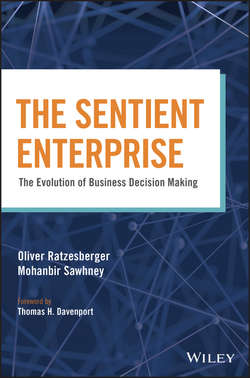Читать книгу The Sentient Enterprise - Ratzesberger Oliver - Страница 7
На сайте Литреса книга снята с продажи.
Introduction
AN EVOLUTIONARY JOURNEY (THAT’S ALREADY BEGUN!)
ОглавлениеThese examples show how we’re on a journey away from monolithic and nonagile IT applications. But a caveat along this journey – one we’ll emphasize often in the course of this book – is that you must fold in the right kind of governance, so your newly agile systems don’t create more problems than they’re solving. We’ll talk through the Wild West pitfalls of data anarchy and error that arise when we try to loosen old systems and rules without putting some kind of (seamless and hassle-free) governance in place to support our new and agile methodologies.
We’ll also see how most of the steps a company takes on the journey to sentience follow this definition of agility as decomposing problems into manageable components. The word is even embedded in the first of the Sentient Enterprise’s five stages – the Agile Data Platform – proof of how front and center agility needs to be for anyone looking to survive and compete in today’s data-driven marketplace.
Fortunately, we’re not at square one in fulfilling the mandate for more agility and sentience around data in the enterprise; far from it! During his time at eBay, and now at Teradata, the practitioner on your coauthor team (Oliver) has worked to create collaborative and agile platforms for analytics. In the same spirit as OSI’s abstraction layers, analytic platforms help data scientists and other users convene and extract insights around data safely and profitably.
The Sentient Enterprise now elevates this platform approach for collaboration to an entirely new and coordinated level at scale. Among other things, you’ll learn about the Layered Data Architecture, which we’ll discuss more fully in Chapter 2. In a nutshell, it’s like an OSI-style nerve center for your data architecture – a tiered system for concurrent and customized access by many users of different skill levels and job descriptions.
Just as a telephone line worker is dispatched to run cable in the field while a systems traffic engineer is focused productively on routing options – without messing up the lines or each other’s jobs – so the Layered Data Architecture keeps the operations analyst busy and supplied with data on key performance indicators (KPIs) without messing with source systems or fine-granularity modeling that the deep-dive data scientist is preoccupied with.
The Layered Data Architecture is, in turn, a foundation for the five complementary platforms that make up the Sentient Enterprise:
1. Agile Data Platform
2. Behavioral Data Platform
3. Collaborative Ideation Platform
4. Analytical Application Platform
5. Autonomous Decisioning Platform
By setting up an environment of five agile and closely linked platforms, we mature an organization’s capabilities around data. That’s why we refer to the Sentient Enterprise as a “capability maturity model” – not unlike the famous Six Sigma methodology for business processes and quality control – that many organizations can use as a yardstick for building capabilities and success.
